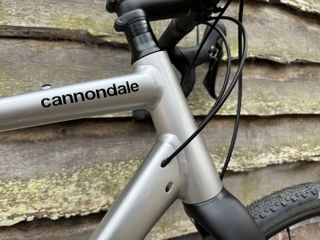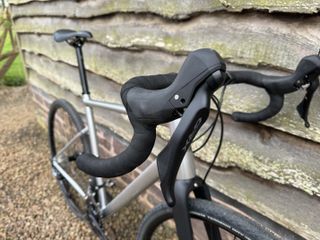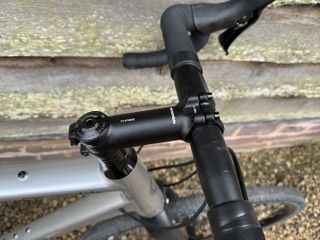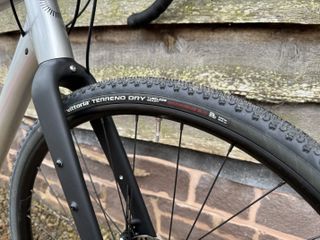Cannondale’s Topstone 1 Alloy gravel bike cuts the cost of entry into one of cycling’s fastest growing segments, offering a value gravel bike option for those keen to enjoy light off-road trails on a machine that still feels fast enough on the tarmac.
The ideal gravel bike is nimble on the road, and can tackle both light gravel and fire roads as well as more technical terrain. The Topstone 1 was capable of all three, but the aluminium frame and seat post, paired with dry-weather tyres, held it back on the more technical sections, whilst it’s more stable geometry meant it feels more like a commuter on the tarmac.
Cannondale Topstone 1 Alloy construction
About Cannondale
Cannondale started in 1971 in a garage in Connecticut revolutionising the use of carbon and aluminium in road bikes and mountain bikes. In 2022 they work with both the EF Education-Cannondale and EF Education–EasyPost world tour cycling teams.
Cannondale themselves have a full range of road, tri, gravel and mountain bikes along with kids, urban and ebikes. Along with bikes and frames, they also have a full repertoire of components, on bike gear, accessories and tools to support all cycling endeavours.
The Cannondale Topstone 1 is built using Cannondale’s lightweight SmartForm C2 Alloy for the frame, with a carbon fibre fork used to assist with vibration dampening at the front. Cable routing is mostly done internally throughout the frame except for along the chainstays where cables exit under the bottom bracket. The frame features three bottle cage mounting holes on the downtube, two on the seattube, two on the toptube, and three either side of the forks. There are also attachment points for mudguards/fenders and panniers.

(Image credit: Andy Turner)
Keeping things in house, Cannondale supplies its own finishing fit with the bar (16 degree flare and 42cm tops, centre to centre and 50cm drops, centre to centre), stem (100mm) and seatpost (25 degree setback) all being their own branded aluminium components. The saddle is Fizik’s Aliante Delta.
The groupset is a mix of Shimano’s GRX 800, 600 and 400 series. With the front and rear mech being 800 and featuring a clutch mechanism, 600 shifters, 400 disc brake callipers with two 160mm RT54 rotors, and finally an 11-34 11-speed 105 cassette. The crankset is an FSA Gossamer Pro Modular AGX+ with 46/36 chainring, FSA BB386 MegaEvo threaded BB, and KMC X11 chain. While wheels are WTB ST i23 TCS rims (12x100mm centerlock F and 12x142mm centerlock R) with Vittoria Terrano Dry tyres in 35mm.
Cannondale Topstone 1 Alloy ride

(Image credit: Andy Turner)
The Cannondale Topstone 1 is an impressively lightweight alloy gravel bike while the alloy frame also provides a good amount of stiffness for responsive power transfer. Paired with the Shimano GRX groupset and 35mm Vittoria Terrano tyres it is quite spritely when it comes to accelerations and taking steeper off-road climbs.
The geometry is nicely suited to its intended use, with a slack headtube (71 degrees) and a long fork offset in what Cannondale calls OutFront steering geometry. This results in a front end that is quite stable at higher speeds, but also allows for rapid changes of direction when required without feeling twitchy. The slack seat tube (73.1 degrees) also aids off-road performance by keeping more of your weight over the rear wheel and helping in avoiding wheel slippage.

(Image credit: Andy Turner)
Taking the bike out and hitting the trails of the Forest of Dean (FoD) on a slightly soggy day, I was really able to put the bike through its paces. The route split the road surfaces into several categories, with a tarmac ride heading out to the trails, some rougher rocky terrain on the pathways up to the trails, some slippery and muddy climbs and descents, pump tracks, and finally some nice fire roads.
The best gravel bikes perform well on the road, as well as off-road. When it comes to tarmac performance, the Topstone is sufficient, but doesn’t excel. Compared to a road bike the slack headtube and long fork offset do feel a little ‘off’ at higher speeds, and the bike is not quite as responsive as most road bikes. Although it is effective on the road, this bike is certainly built for off-road adventures or more relaxed commuting.
It was on rougher, rocky terrain where the first issue arose with the Topstone. When it comes to bumpy surfaces the aluminium frame can be quite unforgiving, jolting you around in the saddle. The aluminium seatpost, Fizik saddle, and fairly narrow 35mm tyres also don’t aid in this very much and the combination leads to a very jarring ride on rougher surfaces. Far more jarring than the Carbon Topstone with 38mm rubber and carbon seatpost. The front forks do however do a decent job of reducing vibration, as does the liberally thick bar tape. But even with a 45mm maximum clearance, the bike’s adventuring capabilities are limited by the standard components and unforgiving frame.

(Image credit: Andy Turner)
Onto the main trails, the Verderers in the FoD, and the bike felt a lot smoother and more fluid on combinations of mud and gravel. At lower speeds the bike turns and handles fast changes in direction really well. The gearing is also ample to deal with some fairly steep off-road gradient, and although the wheels aren’t the lightest, when keeping the pace smooth and consistent they go uphill respectably at lower speeds.
The Terrano Dry tyres, however, didn’t impress me here – although great on dry surfaces, as the name suggests, are not the most grippy on wet mud, even when leaning onto the more heavily treaded sidewalls. Manoeuvring quickly through tight muddy corners was certainly not confidence inspiring and there was quite a lot of rear wheel slippage on the wetter muddier sections. The tyres also come set up as clinchers, for off-road riding I would suggest a move to tubeless both for puncture resistance and also for some added suppleness to the ride.
Upon reaching the Verderers’ Dragon’s Back – a notoriously lumpy and fast downhill section with many pumps and banked corners – the 50cm drops inspired confidence when taking the banked gravel corners, which the bike dealt with very well. Here, on the dry gravel sections, the tyres came into their own, offering good grip and rolling fast – though I would still prefer 38-40mm tyres on this bike to make the most out of off-road performance.
Most at home on gravel trails and fire roads
The bike felt most at home, however, on the gravel trails and fire roads that are perfectly suited to the stiff frame and narrower tyres. And that’s good news, because this is where most riders would use such a bike.
The Topstone glides across these sections effortlessly and with good power transfer deals with inclines very nicely. Whilst I’m still not entirely sold on a 1x set up, the 48/36 and 11/34 combo gave a great range of gears for most scenarios and not too large a jump between any of them, though, perhaps a slightly larger rear sprocket would be appreciated for those that want to take the steeper climbs a little easier.
On the subject of groupset, the Shimano GRX 800/600 mix is superb. The shifting is very clean and precise, even after plenty of rides getting the bike covered in mud. The clutch rear mech system means there is virtually no chain slap over bumpy terrains and assists in the reliable shifting and no chain drop. Braking is also excellent, with quick engagement and good modulation.
Cannondale Topstone 1 Alloy value
When it comes to value the Cannondale Topstone 1 offers a very solid spec for the price, at £2200/$2325.
The mix of Shimano GRX 800 and 600 11 speed components puts it ahead of many gravel bikes that would otherwise offer better value as they mainly come with 10 speed groupsets and less scope for attachments.
However, if you don’t mind 10 speed gearing, the Boardman ADV 8.9 offers a decent bike for £1150, nearly half the price of the Topstone. The Focus Atlas 6.8 offers a very similar spec at £1899 but does have boost wheel spacing so road wheels for commuting are not an option. For not a huge amount more though you can get the Boardman ADV 9.4 with SRAM Rival eTap for £2650.
Cannondale Topstone 1 Alloy conclusion
Overall the Cannondale Topstone is a capable off-road bike able to take in the gravel trails with a lot of ease and confidence. However, it is limited in the scope of terrain that it can tackle with the overly stiff aluminium frame and components meaning that rougher terrain is not comfortable. Value wise the bike is very well equipped, but there are similarly spec bikes at lower prices, however with less flexibility to use as a commuter/winter road bike. If you want a capable gravel bike that can double as a winter training steed, this bike is ideal. For more off-road adventures, something more forgiving would be better.
Specification
- RRP: £2200 / $2325
- 45mm Tyres clearance (40mm with fenders)
- Internal routing dropper ready
- XS-XL (147-203cm tall)
- Lots of bolt options for storage and fenders
- Lightweight SmartForm C2 Alloy frame w/ full carbon fork and 1-1/8″ to 1.5″ steerer
- Shimano GRX 800/600 11-speed shifting
- WTB ST i23 TCS rims (12x100mm centerlock F and 12x142mm centerlock R)
- Vittoria Terreno Dry tyres, 700x35c, foldable
- Fizik Aliante Delta
- Cannondale 3 bar (cc), Stem (mm), and seatpost (setback)
- Shimano GRX 800 front and rear mech, 600 shifters, 400 brakes
- 160/160mm RT54 rotors
- FSA Gossamer Pro Modular AGX+, 46/30
- FSA BB386 MegaEvo threaded BB
- Shimano 105, 11-34, 11-speed cassette
- KMC X11, 11-speed
- Seat tube 55.3cm, 73.1deg, top tube 57.2cm, head tube 18cm, 71deg, standover 82.4cm, wheelbase 106.4cm, chain stay 43.5cm, BB drop 7.5cm, BB height 28.4cm, rake 5.5cm, trail 6.5cm, stack 61cm, reach 39.4cm

